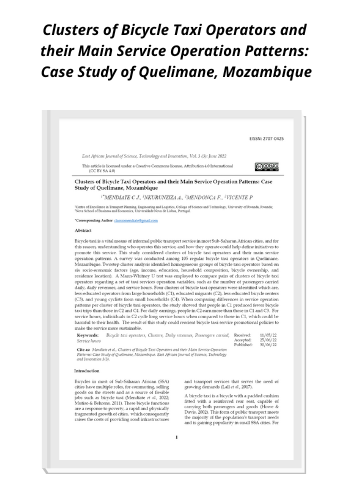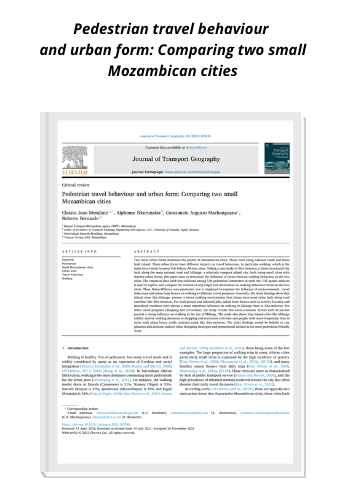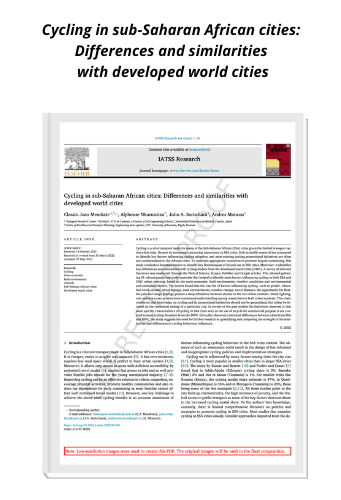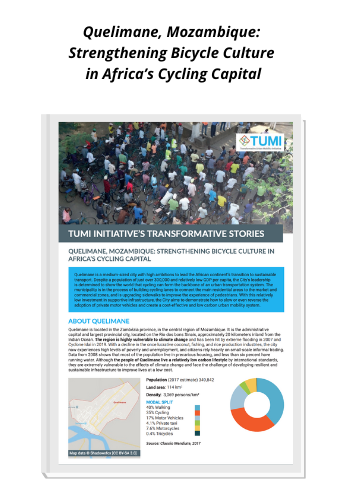
Quelimane’s Bicycle Culture
Quelimane, known as Africa’s cycling city, demonstrates it is possible to slow or even reverse the adoption of private motor vehicles. This municipality stands out for creating cost-effective and low-carbon urban mobility systems.
Why transition to cycling?
Researchers at Universidade Nova de Lisboa documented in “A spatial application of an opportunity costing methodology for the assessment of the climate value of cycling,” the benefits and risks of transitioning to cycling. They applied the “Opportunity Costing Methodology” to the mobility system in Quelimane and demonstrated that cycling contributes to the mitigation of CO2 emissions, as it is inherently a zero-emission form of travel.
Cycling mobility can be seen as a ‘CO2-sink’ because each bicycle trip represents potential CO2 emission when replaced with an alternative motorized transportation mode. The research aims to use the spatial version of the “Opportunity Costing Methodology” which assigns a hypothetical value in CO2 to a bicycle kilometer traveled based on the stated substitution mode for that trip. The study resulted in a climate hypothetical value of cycling of 1,062.4 tonnes of CO2 per year, which will be deducted from the year’s total amount of carbon emissions in this municipality. [1]
In fact, cycling could offer significant commuting benefits for city residents and potentially the entire Sub-Saharan African region [6]
Recent Cycling Projects
To speed the transition to greater bike use, Quelimane leaders developed projects such as building Quelimane’s Cycleway (supported by the Portuguese Government), upgrading sidewalks to improve the experience for pedestrians with additional investment in supportive infrastructure,[2] and approval of bicycle taxi service circulation in the area[3]. These developments have strengthened bicycle culture. Manuel Araujo, Mayor of Quelimane, pointed out that “cycling in Quelimane is more than a mode of transport – it is a tool for social cohesion; it is Quelimane’s identity.” [1]
Cycling culture and next steps for Quelimane
As detailed in the studies Identifying clusters of cycling commuters and travel patterns: The case of Quelimane, Mozambique and the Pedestrian travel behaviour and urban form: Comparing two small Mozambican cities by researchers at the Universidade Nova de Lisboa, Quelimane continues to face many challenges implementing an active mobility culture. Specifically, cyclists are exposed to risk and inconvenience due to a lack of safe cycling infrastructure.
As a result, Quelimane officials will work on new policies and strategies to promote safe walking in the neighborhoods along or crossed by busy national roads – particularly on the main crossings to schools – [5], as well as safe bicycle parking in schools to reduce bicycle theft, encourage cycling to school, and discourage motor vehicle use, particularly for short travel distances. Officials will also map cyclists’ travel patterns for specific zones, which is crucial to define the geographical areas where customized policies can be implemented. In addition, officials aim to reduce travel time, particularly when connecting residential zones with large market areas and considering attitudinal variables in identifying homogeneous groups of commuter cyclists. This process should lay out the different needs of various groups of commuter cyclists, with the goal of implementing the best possible solutions tailored to each profile.[4]
Take a look at the following reports that have showcase Quelimane’s transition to cycling in detail.
- A spatial application of an opportunity costing methodology for the assessment of the climate value of cycling
- Quelimane, Mozambique: Strengthening Bicycle Culture in Africa’s Cycling Capital
- Clusters of Bicycle Taxi Operators and their Main Service Operation Patterns: Case Study of Quelimane, Mozambique
- Identifying clusters of cycling commuters and travel patterns: The case of Quelimane, Mozambique
- Pedestrian travel behaviour and urban form: Comparing two small Mozambican cities
- Cycling in sub-Saharan African cities: Differences and similarities with developed world cities






